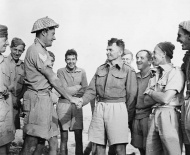Events In History
-
 11 May 1945Upham presented with VC
11 May 1945Upham presented with VCNew Zealand's most-decorated soldier was recognised for his outstanding gallantry and leadership in Crete in 1941 and Egypt in 1942. He remains the only combat soldier to have been awarded a Bar to his Victoria Cross. Read more...
-
 2 November 1942NZ Division helps Allies break through at El Alamein
2 November 1942NZ Division helps Allies break through at El AlameinThe 2nd New Zealand Division opened the way for British armour, allowing the Allies to make a decisive breakthrough at El Alamein, Egypt, and send the Axis forces into retreat. Read more...
-
 17 August 1942Attack on the Nino Bixio
17 August 1942Attack on the Nino Bixio118 New Zealand prisoners of war died when the Italian transport ship Nino Bixio was torpedoed by a British submarine in the Mediterranean. Read more...
Articles
The North African Campaign

The second battle of El Alamein, which began 70 years ago this month, was the turning point of the war in North Africa. For New Zealand forces, this was longest and most important land campaign of WWII. But victory came at a heavy price: between 1941 and 1943, 14,000 Kiwis were killed, wounded or became prisoners of war.
-
Page 2 – Background
Fighting in North Africa stemmed from the area’s strategic importance to the Commonwealth. Italy’s decision in June 1940 to enter the war on Germany’s side seriously
-
Page 3 – Operation Crusader
As British forces crushed the Italians in Abyssinia, elements of the Deutsches Afrika Korps (German Africa Corps) began arriving in Libya and the 2nd New Zealand Division
-
Page 4 – El Alamein
The New Zealand Division fell back to the Alamein Line, where it took part in the first Battle of El Alamein. They suffered heavy casualties at Ruweisat Ridge and El Mreir
-
Page 5 – Tunisia and victory
The New Zealand Division enters Tunisia fighting fierce battles at Tebaga Gap and Takrouna. In May 1943 Axis forces in North Africa surrender and the New Zealanders begin a
-
Page 6 – The North African Campaign timeline
Timeline showing key events of the Second World War, particularly New Zealand's involvement in North Africa.
-
Page 7 – Kiwi stories
Selected audio extracts of New Zealanders involved in the North African Campaign.
-
Page 8 – Further information
This web feature was written by Megan Hutching and Ian McGibbon and produced by the NZHistory.net.nz team. In 2011 it was revised by Gareth Phipps. Links
War oral history programme

Information about the now completed From Memory oral history project, including advice on how to interview war veterans
- Page 7 - Notes and questions, North AfricaQuestions for oral history interviews with veterans of the North African
Biographies
-
 Freyberg, Bernard Cyril
Freyberg, Bernard Cyril
A First World War hero and commander of the 2nd New Zealand Expeditionary Force, Bernard Freyberg proved to be a charismatic and popular military leader who would later serve a term as Governor-General
Read more... -
 Upham, Charles Hazlitt
Upham, Charles Hazlitt
Charles Upham is probably New Zealand's most famous soldier. His actions in Crete in 1941 and Egypt in 1942 led to his becoming one of only three people – and the only combat soldier – ever to win the Victoria Cross twice.
Read more... -
 Kippenberger, Howard Karl
Kippenberger, Howard Karl
Leader of the 5th New Zealand Infantry Brigade in the North African desert campaigns of 1942 and 1943, Kippenberger was New Zealand’s most popular military commander, and perhaps its most talented.
Read more...
Related keywords
- te uku
- royal new zealand air force
- WW2
- howard kippenberger
- battle of cassino
- el alamein
- italian campaign
- battle for crete
- charles upham
- victoria cross
- oral history
- shipping
- prisoners of war
- amberley
- roadside stories
- artillery
- interviewing veterans
- maori battalion
- keith elliott
- erwin rommel
- war art
- peter mcintyre
- wairarapa rugby
- WW1
- governor-general
- bernard freyberg
- swimming
- transport
- womens war service auxiliary
- tui
- war objects
- germany
- leisure
- sport
- wilfred weakly
- maps
- movies
- rugby
- prostitution
- WW2 stories
- maori in war
- haane manahi
- te arawa
- weapons
- timeline
- ngarimu
- anzac day
- egypt
-
Main image: Moon memorial church, Te Uku
In 1945 Arthur and Jessie Moon donated land and money to establish a church and cemetery at Te Uku, near Raglan, as a memorial to their son.





































